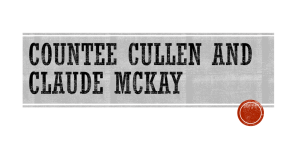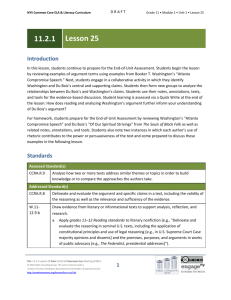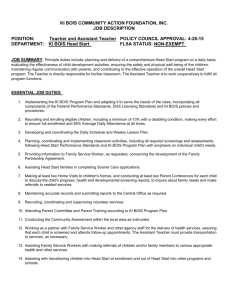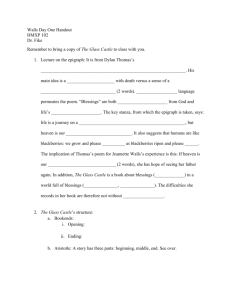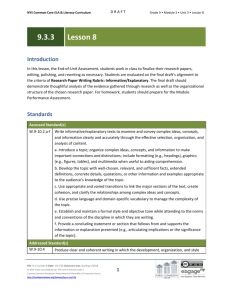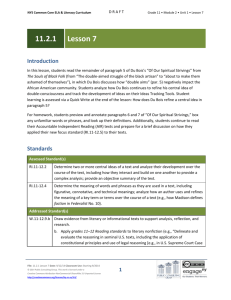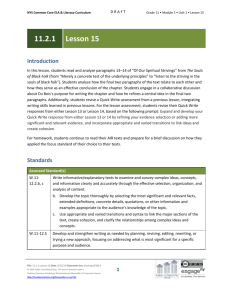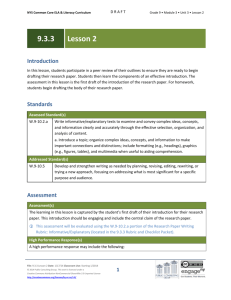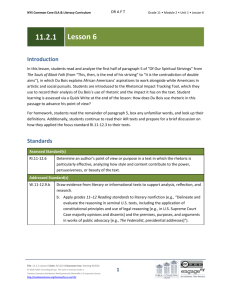Lesson Agenda/Overview
advertisement
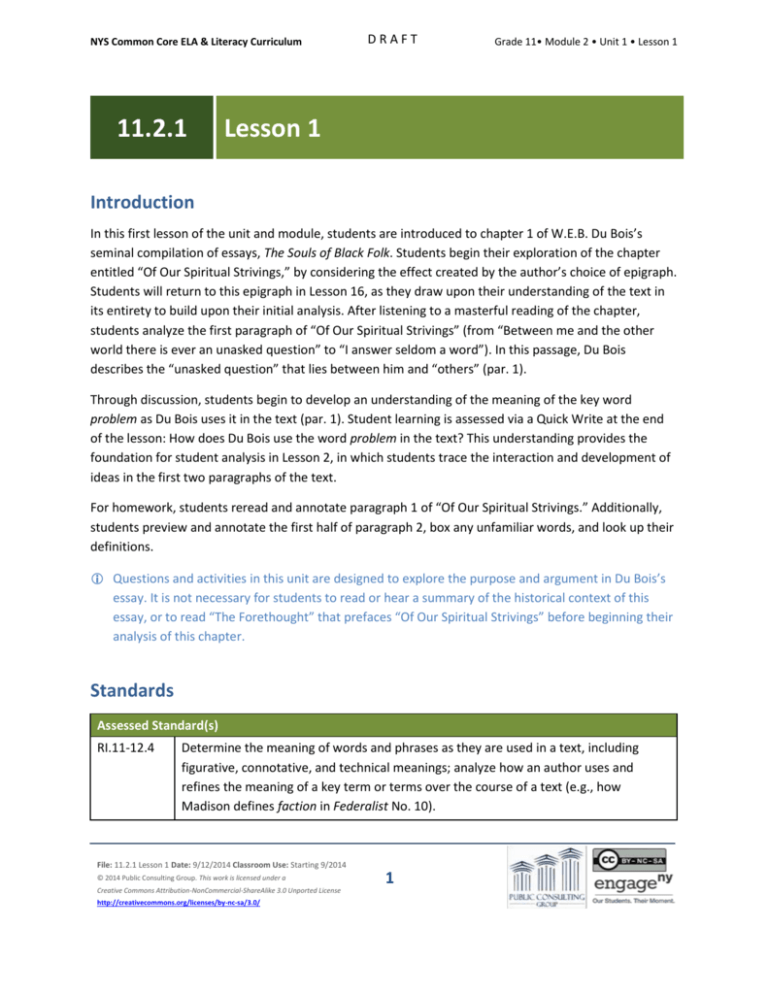
NYS Common Core ELA & Literacy Curriculum 11.2.1 DRAFT Grade 11• Module 2 • Unit 1 • Lesson 1 Lesson 1 Introduction In this first lesson of the unit and module, students are introduced to chapter 1 of W.E.B. Du Bois’s seminal compilation of essays, The Souls of Black Folk. Students begin their exploration of the chapter entitled “Of Our Spiritual Strivings,” by considering the effect created by the author’s choice of epigraph. Students will return to this epigraph in Lesson 16, as they draw upon their understanding of the text in its entirety to build upon their initial analysis. After listening to a masterful reading of the chapter, students analyze the first paragraph of “Of Our Spiritual Strivings” (from “Between me and the other world there is ever an unasked question” to “I answer seldom a word”). In this passage, Du Bois describes the “unasked question” that lies between him and “others” (par. 1). Through discussion, students begin to develop an understanding of the meaning of the key word problem as Du Bois uses it in the text (par. 1). Student learning is assessed via a Quick Write at the end of the lesson: How does Du Bois use the word problem in the text? This understanding provides the foundation for student analysis in Lesson 2, in which students trace the interaction and development of ideas in the first two paragraphs of the text. For homework, students reread and annotate paragraph 1 of “Of Our Spiritual Strivings.” Additionally, students preview and annotate the first half of paragraph 2, box any unfamiliar words, and look up their definitions. Questions and activities in this unit are designed to explore the purpose and argument in Du Bois’s essay. It is not necessary for students to read or hear a summary of the historical context of this essay, or to read “The Forethought” that prefaces “Of Our Spiritual Strivings” before beginning their analysis of this chapter. Standards Assessed Standard(s) RI.11-12.4 Determine the meaning of words and phrases as they are used in a text, including figurative, connotative, and technical meanings; analyze how an author uses and refines the meaning of a key term or terms over the course of a text (e.g., how Madison defines faction in Federalist No. 10). File: 11.2.1 Lesson 1 Date: 9/12/2014 Classroom Use: Starting 9/2014 © 2014 Public Consulting Group. This work is licensed under a Creative Commons Attribution-NonCommercial-ShareAlike 3.0 Unported License http://creativecommons.org/licenses/by-nc-sa/3.0/ 1 NYS Common Core ELA & Literacy Curriculum DRAFT Grade 11• Module 2 • Unit 1 • Lesson 1 Addressed Standard(s) W.11-12.9.b Draw evidence from literary or informational texts to support analysis, reflection, and research. b. Apply grades 11–12 Reading standards to literary nonfiction (e.g., "Delineate and evaluate the reasoning in seminal U.S. texts, including the application of constitutional principles and use of legal reasoning [e.g., in U.S. Supreme Court Case majority opinions and dissents] and the premises, purposes, and arguments in works of public advocacy [e.g., The Federalist, presidential addresses]"). L.11-12.4.a Determine or clarify the meaning of unknown and multiple-meaning words and phrases based on grades 11–12 reading and content, choosing flexibly from a range of strategies. a. Use context (e.g., the overall meaning of a sentence, paragraph, or text; a word’s position or function in a sentence) as a clue to the meaning of a word or phrase. Assessment Assessment(s) Student learning is assessed via a Quick Write at the end of the lesson. Students respond to the following prompt, citing textual evidence to support analysis and inferences drawn from the text. How does Du Bois use the word problem in the text? Throughout this unit, Quick Writes will be evaluated using the Short Response Rubric. High Performance Response(s) A High Performance Response should: Determine how Du Bois uses the word problem in the text (e.g., Du Bois uses the word problem to refer to how the “other world” (par. 1) sees him. This is evidenced by Du Bois’s belief that people who consider him to be different all want to ask him the question: “How does it feel to be a problem?”(par. 1). This question demonstrates that the people who want to ask it believe that Du Bois is a problem, even if they do not actually ask this question because of “feelings of delicacy” (par. 1), or because they do not know how to address it.). File: 11.2.1 Lesson 1 Date: 9/12/2014 Classroom Use: Starting 9/2014 © 2014 Public Consulting Group. This work is licensed under a Creative Commons Attribution-NonCommercial-ShareAlike 3.0 Unported License http://creativecommons.org/licenses/by-nc-sa/3.0/ 2 NYS Common Core ELA & Literacy Curriculum DRAFT Grade 11• Module 2 • Unit 1 • Lesson 1 Vocabulary Vocabulary to provide directly (will not include extended instruction) strivings (n.) – strenuous efforts toward a goal delicacy (n.) – refined sensibility in feeling or conduct mournful (adj.) – full of sorrow, very sad avail (n.) – help toward reaching a goal Vocabulary to teach (may include direct word work and/or questions) None. Additional vocabulary to support English Language Learners (to provide directly) o (interjection) – archaic or poetic form of “oh,” used to address someone directly till (prep.) – archaic or poetic form of until, meaning up to (a particular time) weary (adj.) – lacking strength, energy, or freshness because of a need for rest or sleep Lesson Agenda/Overview Student-Facing Agenda % of Lesson Standards & Text: Standards: RI.11-12.4, W.11-12.9.b, L.11-12.4.a Text: The Souls of Black Folk by W.E.B. Du Bois, Chapter 1: “Of Our Spiritual Strivings,” paragraph 1 (Masterful Reading: Chapter 1: “Of Our Spiritual Strivings”) Learning Sequence: 1. 2. 3. 4. 5. 6. Introduction of the Module and Lesson Agenda Homework Accountability Masterful Reading Reading and Discussion Quick Write Closing 1. 2. 3. 4. 5. 6. File: 11.2.1 Lesson 1 Date: 9/12/2014 Classroom Use: Starting 9/2014 © 2014 Public Consulting Group. This work is licensed under a Creative Commons Attribution-NonCommercial-ShareAlike 3.0 Unported License http://creativecommons.org/licenses/by-nc-sa/3.0/ 3 10% 15% 45% 15% 10% 5% NYS Common Core ELA & Literacy Curriculum DRAFT Grade 11• Module 2 • Unit 1 • Lesson 1 Materials Copies of the 11.2 Common Core Learning Standards Tool for each student Copies of “Of Our Spiritual Strivings” for each student (with paragraphs numbered 1–14) Copies of the Short Response Rubric and Checklist for each student Consider numbering the paragraphs of “Of Our Spiritual Strivings” before the lesson. Learning Sequence How to Use the Learning Sequence Symbol Type of Text & Interpretation of the Symbol 10% no symbol Percentage indicates the percentage of lesson time each activity should take. Plain text indicates teacher action. Bold text indicates questions for the teacher to ask students. Italicized text indicates a vocabulary word. Indicates student action(s). Indicates possible student response(s) to teacher questions. Indicates instructional notes for the teacher. Activity 1: Introduction of the Module and Lesson Agenda 10% Begin by sharing the goals for this module and unit. Explain to students that in the second module of eleventh grade, they read, discuss, and analyze informational texts and poetry, focusing on how authors use language, structure, and rhetoric to analyze complex ideas and events, develop an argument, convey a point of view, or advance a purpose. Explain that throughout this module, students consider how these texts address similar ideas in order to compare the approaches the authors take, and build knowledge of these shared subjects. Through focused writing instruction, practice, and revision, students develop and strengthen the skills required to write explanatory texts that clearly and effectively examine and convey complex ideas, concepts, and information. In this first unit of the module, students read chapter 1 of W.E.B. Du Bois’s The Souls of Black Folk, “Of Our Spiritual Strivings” in relation to Booker T. Washington’s “Atlanta Compromise Speech,” noting the authors’ divergent arguments. Students follow along. Begin by reviewing the agenda and assessed standard for this lesson: RI.11-12.4. In this lesson, students analyze the use of a key word in the first paragraph of “Of Our Spiritual Strivings.” File: 11.2.1 Lesson 1 Date: 9/12/2014 Classroom Use: Starting 9/2014 © 2014 Public Consulting Group. This work is licensed under a Creative Commons Attribution-NonCommercial-ShareAlike 3.0 Unported License http://creativecommons.org/licenses/by-nc-sa/3.0/ 4 NYS Common Core ELA & Literacy Curriculum DRAFT Grade 11• Module 2 • Unit 1 • Lesson 1 Students look at the agenda. Distribute a copy of the 11.2 Common Core Learning Standards Tool to each student. Inform students that in this lesson, they begin to work with a new standard: RI.11-12.4. Instruct students to individually read this standard on their tools and assess their familiarity with and mastery of it. Students read and assess their familiarity with the standard RI.11-12.4. Instruct students to form pairs and compare their understanding of RI.11-12.4 with their understanding of the familiar standard RL.11-12.4. Student responses should include: o o Both RI.11.12.4 and RL.11-12.4 include determining the figurative and connotative meanings of words and phrases in a text, but RI.11-12.4 includes determining technical meanings as well. RL.11-12.4 includes analyzing how word choices affect meaning and tone, whereas RI.1112.4 focuses on just meaning because it only requires analyzing how an author uses and refines the meaning of key term over the course of a text. Lead a brief whole-class discussion based on student responses. Activity 2: Homework Accountability 15% Instruct students to take out their homework from the previous lesson. (Read and annotate Arthur Symons’ poem “The Crying of Water,” the epigraph to “Of Our Spiritual Strivings” by W.E.B Du Bois, and box any unfamiliar words and look up their definitions.) Students take out their homework. Consider reminding students that an epigraph is a quotation at the beginning of a text or a section of a text, suggesting the text’s theme or central idea. Students were introduced to the term epigraph in 9.1.1 Lesson 1. Instruct students to form pairs and share the vocabulary words they identified and defined in the previous lesson’s homework. Students may identify the following words: mournful, avail. Definitions are provided in the Vocabulary box in this lesson. Differentiation Consideration: Consider providing students with the following definitions: o means “an archaic or poetic form of ‘oh’ used to address someone directly,” till means “an archaic or poetic File: 11.2.1 Lesson 1 Date: 9/12/2014 Classroom Use: Starting 9/2014 © 2014 Public Consulting Group. This work is licensed under a Creative Commons Attribution-NonCommercial-ShareAlike 3.0 Unported License http://creativecommons.org/licenses/by-nc-sa/3.0/ 5 NYS Common Core ELA & Literacy Curriculum DRAFT Grade 11• Module 2 • Unit 1 • Lesson 1 form of until, meaning up to (a particular time),” and weary means “lacking strength, energy, or freshness because of a need for rest or sleep.” Students write the definitions of o, till, and weary on their copies of the text or in a vocabulary journal. Instruct students to discuss their annotations in pairs. Consider reviewing and displaying the following annotation codes established in Module 11.1: o Box unfamiliar words. o Star (*) important or repeating ideas. o Put a question mark (?) next to a section you are questioning or confused about, and write your question down. o Use an exclamation point (!) for connections between ideas or ideas that strike or surprise you in some way, and provide a brief note explaining the connections. Remind students that, in addition to using codes, marking the text with their thinking in relation to the codes is important. Students share their annotations. Student annotations may include: o o o Stars next to the repeating phrases “O water” (chapter 1 epigraph, lines 1, 5), “voice of my heart” (chapter 1 epigraph, lines 1, 4), “[I]s it I?” (chapter 1 epigraph, line 5), “crying to me” (chapter 1 epigraph, lines 6, 12), and “[a]ll night long” (chapter 1 epigraph, lines 2, 6). A question mark next to “O water, voice of my heart” (chapter 1 epigraph, line 1). How can water be a voice? Is the water Symons talking about real, or metaphorical? An exclamation point to connect the first line of the first stanza, “O water, voice of my heart, crying in the sand” (chapter 1 epigraph, line 1), with the final line of the second stanza, “the water all night long is crying to me” (chapter 1 epigraph, line 12). The poem begins and ends with the same image. Post or project the following questions for students to answer in their pairs. Remind students to use their annotations to guide their responses to these questions. Describe the speaker’s tone in this poem. What words or phrases create this tone? File: 11.2.1 Lesson 1 Date: 9/12/2014 Classroom Use: Starting 9/2014 © 2014 Public Consulting Group. This work is licensed under a Creative Commons Attribution-NonCommercial-ShareAlike 3.0 Unported License http://creativecommons.org/licenses/by-nc-sa/3.0/ 6 NYS Common Core ELA & Literacy Curriculum DRAFT Grade 11• Module 2 • Unit 1 • Lesson 1 Student responses may include: o o The repetition of the words “cry” (chapter 1 epigraph, lines 2, 10) and “crying” (chapter 1 epigraph, lines 1–2, 5–6, 11–12), the use of the word “mournful” (chapter 1 epigraph, line 2), and the phrase “crying without avail” (chapter 1 epigraph, line 11) create a sorrowful or sad tone. The word “unresting” (chapter 1 epigraph, line 7) and the phrases “there shall never be rest” (chapter 1 epigraph, line 7), “the heart shall be weary and wonder” (chapter 1 epigraph, line 10), “cannot understand” (chapter 1 epigraph, line 3), and the repetition of the unanswered question “[I]s it I?” (chapter 1 epigraph, line 5) create a tone of conflict, or confusion. The speaker has questions that cannot be answered, and cannot rest because of them. Students were introduced to tone in 11.1.1 Lesson 1 in their analysis of Robert Browning’s “My Last Duchess.” If necessary, remind students that tone is the attitude a speaker has towards the subject about which they are speaking. What can you infer about this chapter from Du Bois’s choice of epigraph? Student responses may include: o o o The repetition of the word “crying” (chapter 1 epigraph, 1–2, 5–6, 11–12), the use of the word “mournful” (chapter 1 epigraph, line 2), and the phrase “crying without avail” (chapter 1 epigraph, line 11) creates a sad tone, and suggests that this chapter might be serious or sad. The use of the phrase “crying without avail” (chapter 1 epigraph, line 11), the word “unresting” (chapter 1 epigraph, line 7), and the phrases “there shall never be rest” (chapter 1 epigraph, line 7) and “the heart shall be weary and wonder” (chapter 1 epigraph, line 10) suggest that the chapter will be about someone looking for something and having difficulty finding it. The phrase “cannot understand” (chapter 1 epigraph, line 3) and the question “[I]s it I?” (chapter 1 epigraph, line 5) create a tone of confusion, and suggest that the chapter will be about conflict or confusion. Lead a brief whole-class discussion of student responses. Students build upon this initial analysis when they return to Symons’ poem in Lesson 16, in which they draw upon their understanding of the text in its entirety to analyze how the poem contributes to the overall meaning and tone of “Of Our Spiritual Strivings.” File: 11.2.1 Lesson 1 Date: 9/12/2014 Classroom Use: Starting 9/2014 © 2014 Public Consulting Group. This work is licensed under a Creative Commons Attribution-NonCommercial-ShareAlike 3.0 Unported License http://creativecommons.org/licenses/by-nc-sa/3.0/ 7 NYS Common Core ELA & Literacy Curriculum DRAFT Grade 11• Module 2 • Unit 1 • Lesson 1 Activity 3: Masterful Reading 45% Have students listen to a masterful reading of chapter 1 “Of Our Spiritual Strivings” in its entirety (from “Between me and the other world” to “the striving in the souls of black folk” (par. 1–14)). Inform students that they will follow along and pause twice during the chapter (after paragraphs 4 and 9) to write down their initial questions and reactions. Students follow along, reading silently, and then write initial reactions and questions. Differentiation Consideration: Consider pausing more frequently during the masterful reading to allow students more opportunities to write questions and reactions. Differentiation Consideration: Consider posting or projecting the following guiding question to support students throughout this lesson: What does Du Bois use the word problem to describe in this text? Lead a brief class discussion of students’ initial reactions and questions. Remind students that as they analyze the text throughout the unit, they will answer many of these initial questions. Student responses may include: o o o o o o o o o o What is the “other world” (par. 1)? Who occupies it? Why do the people Du Bois describes in the first paragraph consider him to be “a problem” (par. 1)? Du Bois refers to “with other black boys” (par. 2)—does this mean that the “problem” (par. 1) has something to do with being African American? Du Bois writes about being “an American” (par. 3) and being “a Negro” (par. 3) like they are two separate entities. Can a person not be both at the same time? Why does Du Bois capitalize “Opportunity” (par. 4) and “Emancipation” (par. 5)? Du Bois writes “in the few days since Emancipation” (par. 5), which suggests that he is writing about the time after slaves were freed. Du Bois writes that despite Emancipation, people are still not free (par. 7). If Emancipation did not free African Americans, what does Du Bois think freedom is? Du Bois describes all African Americans as “handicapped” (par. 10). Why would Du Bois use the word “handicapped”? What does he mean by this? Du Bois writes of “the ideal of human brotherhood” (par. 12). Where do women fit into this “ideal”? Despite his criticism of what is happening in America, Du Bois appears to believe in “the greater ideals of the American Republic” (par. 12). File: 11.2.1 Lesson 1 Date: 9/12/2014 Classroom Use: Starting 9/2014 © 2014 Public Consulting Group. This work is licensed under a Creative Commons Attribution-NonCommercial-ShareAlike 3.0 Unported License http://creativecommons.org/licenses/by-nc-sa/3.0/ 8 NYS Common Core ELA & Literacy Curriculum DRAFT Grade 11• Module 2 • Unit 1 • Lesson 1 Consider recording questions and observations on the board or on chart paper for the class to reference throughout the unit, and encourage students to respond and add to these questions as they continue to analyze this text. Du Bois uses the word “Negro” to describe African Americans throughout the chapter. Students should use Du Bois’s language when reading or citing textual evidence, but they should avoid using the word “Negro” in discussion when they are not quoting from the chapter. Activity 4: Reading and Discussion 15% Instruct students to form pairs. Post or project each set of questions below for students to discuss. Instruct students to continue to annotate the text as they read and discuss. This annotation exercise supports students’ engagement with W.11-12.9.b, which addresses the use of textual evidence in writing. Differentiation Consideration: To further support comprehension of and fluency with Du Bois’s complex syntax, consider having students listen to a second masterful reading of paragraph 1 before independently engaging with the text. Instruct student pairs to read from “Between me and the other world there is ever an unasked question” to “I answer seldom a word” (par. 1), and answer the following questions before sharing out with the class. Provide students with the following definitions: strivings means “strenuous efforts toward a goal” and delicacy means “refined sensibility in feeling or conduct.” Students write the definitions of strivings and delicacy on their copies of the text or in a vocabulary journal. Consider explaining to students that “colored” was a term historically used in the United States to describe African Americans in a derogatory way. What is the “unasked question”? The “unasked question” is: “How does it feel to be a problem?” Why is the question “unasked”? Du Bois writes that the question is “unasked” because of “feelings of delicacy” and “the difficulty of rightly framing it.” This suggests that people do not ask the question because it would not be polite to do so, and because something about the question makes it difficult to ask. File: 11.2.1 Lesson 1 Date: 9/12/2014 Classroom Use: Starting 9/2014 © 2014 Public Consulting Group. This work is licensed under a Creative Commons Attribution-NonCommercial-ShareAlike 3.0 Unported License http://creativecommons.org/licenses/by-nc-sa/3.0/ 9 NYS Common Core ELA & Literacy Curriculum DRAFT Grade 11• Module 2 • Unit 1 • Lesson 1 After listening to a masterful reading of the text in its entirety, students may make the connection between race and the “feelings of delicacy,” and the “half-hesitant” approach of “others” (par. 1). This is a crucial connection students develop through further analysis of paragraphs 1 and 2 in 11.2.1 Lessons 2 and 3. Differentiation Consideration: If students struggle to determine why the question remains unasked, consider posing the following scaffolding questions: What words or phrases does Du Bois use to describe how “others” approach him? What can you infer from these descriptions about why the question remains “unasked”? Student responses should include: o o Du Bois describes “others” as “flutter[ing] round” the question, “half-hesitant” and “eye[ing] [him] curiously or compassionately,” avoiding asking the question on their minds because of “feelings of delicacy.” These descriptions suggest that the question remains unasked because people feel uncomfortable approaching Du Bois. Although they appear to be intrigued by him and want to speak with him, they do not ask the question because they are unsure how to ask it. This suggests that the question on their minds concerns a complex subject that is not easily spoken about. To whom does the “problem” refer? The “unasked question … How does it feel to be a problem?” is “between” Du Bois and the “other world,” indicating that the “problem” refers to Du Bois. Additionally, the phrase “they approach me” indicates that this reference is to Du Bois. After listening to a masterful reading of the text in its entirety, students may infer that the “problem” refers more broadly to all African Americans, not just the author. Throughout this unit, students explore the broader meanings of the word problem as it is used and refined over the course of the text. Who or what does Du Bois mean by “the other world”? Du Bois means that the “others” who “flutter round” the question and “approach [him] in a halfhesitant sort of way,” while they “eye [him] curiously or compassionately,” are the “other world.” These references suggest that Du Bois uses the term “other world” to describe people who consider the author to be different or “a problem.” Consider drawing students’ attention to their work with L.11-12.4.a as they use context clues to determine the meaning of the phrase “the other world” in this context. File: 11.2.1 Lesson 1 Date: 9/12/2014 Classroom Use: Starting 9/2014 © 2014 Public Consulting Group. This work is licensed under a Creative Commons Attribution-NonCommercial-ShareAlike 3.0 Unported License http://creativecommons.org/licenses/by-nc-sa/3.0/ 10 NYS Common Core ELA & Literacy Curriculum DRAFT Grade 11• Module 2 • Unit 1 • Lesson 1 After listening to a masterful reading of the text in its entirety, students may infer that “the other world” (par. 1) refers to “the white world” (par. 5). Students continue to explore the meaning of “the other world” in 11.2.1 Lessons 2 and 3. Lead a brief whole-class discussion of student responses. Activity 5: Quick Write 10% Instruct students to respond briefly in writing to the following prompt: How does Du Bois use the word problem in the text? Instruct students to look at their annotations to find evidence. Ask students to use this lesson’s vocabulary wherever possible in their written responses. Remind students to use the Short Response Rubric and Checklist to guide their written responses. Students listen and read the Quick Write prompt. Display the prompt for students to see, or provide the prompt in hard copy. Remind students of their work with the Short Response Rubric and Checklist in Module 11.1. Review the rubric and checklist as necessary. Transition to the Independent Quick Write. Students independently answer the prompt using evidence from the text. See the High Performance Response at the beginning of this lesson. Activity 6: Closing 5% Display and distribute the homework assignment. For homework, instruct students to reread and annotate paragraph 1 (from “Between me and the other world there is ever an unasked question” to “I answer seldom a word”) and preview and annotate the first half of paragraph 2 (from “And yet, being a problem is a strange experience” to “but shut out from their world by a vast veil”). Instruct students to box any unfamiliar words from the first half of paragraph 2 and look up their definitions. Instruct students to choose the definition that makes the most sense in context, and write a brief definition above or near the word in the text. Students follow along. File: 11.2.1 Lesson 1 Date: 9/12/2014 Classroom Use: Starting 9/2014 © 2014 Public Consulting Group. This work is licensed under a Creative Commons Attribution-NonCommercial-ShareAlike 3.0 Unported License http://creativecommons.org/licenses/by-nc-sa/3.0/ 11 NYS Common Core ELA & Literacy Curriculum DRAFT Grade 11• Module 2 • Unit 1 • Lesson 1 Homework Reread and annotate paragraph 1 (from “Between me and the other world there is ever an unasked question” to “I answer seldom a word”), and preview and annotate the first half of paragraph 2 (from “And yet, being a problem is a strange experience” to “but shut out from their world by a vast veil”). Box any unfamiliar words in the first half of paragraph 2 and look up their definitions. Choose the definition that makes the most sense in context, and write a brief definition above or near the word in the text. File: 11.2.1 Lesson 1 Date: 9/12/2014 Classroom Use: Starting 9/2014 © 2014 Public Consulting Group. This work is licensed under a Creative Commons Attribution-NonCommercial-ShareAlike 3.0 Unported License http://creativecommons.org/licenses/by-nc-sa/3.0/ 12 DRAFT NYS Common Core ELA & Literacy Curriculum Grade 11• Module 2 • Unit 1 • Lesson 1 11.2 Common Core Learning Standards Tool Name: Class: College and Career Readiness Anchor Standards— Reading CCRA.R.8. I know what this is asking and I can do this. This standard has familiar language, but I haven’t mastered it. I am not familiar with this standard. I know what this is asking and I can do this. This standard has familiar language, but I haven’t mastered it. I am not familiar with this standard. Delineate and evaluate the argument and specific claims in a text, including the validity of the reasoning as well as the relevance and sufficiency of the evidence. CCS Standards: Reading—Informational RI.11-12.4 Date: Determine the meaning of words and phrases as they are used in a text, including figurative, connotative, and technical meanings; analyze how an author uses and refines the meaning of a key term or terms over the course of a text (e.g., how Madison defines faction in Federalist No. 10). File: 11.2.1 Lesson 1 Date: 9/12/2014 Classroom Use: Starting 9/2014 © 2014 Public Consulting Group. This work is licensed under a Creative Commons Attribution-NonCommercial-ShareAlike 3.0 Unported License http://creativecommons.org/licenses/by-nc-sa/3.0/ 13 NYS Common Core ELA & Literacy Curriculum CCS Standards: Writing W.11-12.4 Grade 11• Module 2 • Unit 1 • Lesson 1 I know what this is asking and I can do this. This standard has familiar language, but I haven’t mastered it. I am not familiar with this standard. I know what this is asking and I can do this. This standard has familiar language, but I haven’t mastered it. I am not familiar with this standard. Produce clear and coherent writing in which the development, organization, and style are appropriate to task, purpose, and audience. CCS Standards: Speaking and Listening SL.11-12.3 DRAFT Evaluate a speaker's point of view, reasoning, and use of evidence and rhetoric, assessing the stance, premises, links among ideas, word choice, points of emphasis, and tone used. File: 11.2.1 Lesson 1 Date: 9/12/2014 Classroom Use: Starting 9/2014 © 2014 Public Consulting Group. This work is licensed under a Creative Commons Attribution-NonCommercial-ShareAlike 3.0 Unported License http://creativecommons.org/licenses/by-nc-sa/3.0/ 14 NYS Common Core ELA & Literacy Curriculum CCS Standards: Language L.11-12.3.a. DRAFT I know what this is asking and I can do this. Apply knowledge of language to understand how language functions in different contexts, to make effective choices for meaning or style, and to comprehend more fully when reading or listening. a. Vary syntax for effect, consulting references (e.g., Tufte's Artful Sentences) for guidance as needed; apply an understanding of syntax to the study of complex texts when reading. File: 11.2.1 Lesson 1 Date: 9/12/2014 Classroom Use: Starting 9/2014 © 2014 Public Consulting Group. This work is licensed under a Creative Commons Attribution-NonCommercial-ShareAlike 3.0 Unported License http://creativecommons.org/licenses/by-nc-sa/3.0/ 15 Grade 11• Module 2 • Unit 1 • Lesson 1 This standard has familiar language, but I haven’t mastered it. I am not familiar with this standard. DRAFT NYS Common Core ELA & Literacy Curriculum Grade 11• Module 2 • Unit 1 • Lesson 1 Short Response Rubric Assessed Standard: Conventions Evidence Analysis Inferences/Claims Name: Class: Date: 2-Point Response 1-Point Response 0-Point Response Includes valid inferences or claims from the text. Includes inferences or claims that are loosely based on the text. Does not address any of the requirements of the prompt or is totally inaccurate. Fully and directly responds to the prompt. Responds partially to the prompt or does not address all elements of the prompt. Includes evidence of reflection and analysis of the text. A mostly literal recounting of events or details from the text(s). The response is blank. Includes relevant and sufficient textual evidence to develop response according to the requirements of the Quick Write. Includes some relevant facts, definitions, concrete details, and/or other information from the text(s) to develop an analysis of the text according to the requirements of the Quick Write. The response includes no evidence from the text. Uses complete sentences where errors do not impact readability. Includes incomplete sentences or bullets. The response is unintelligible or indecipherable. File: 11.2.1 Lesson 1 Date: 9/12/2014 Classroom Use: Starting 9/2014 © 2014 Public Consulting Group. This work is licensed under a Creative Commons Attribution-NonCommercial-ShareAlike 3.0 Unported License http://creativecommons.org/licenses/by-nc-sa/3.0/ 16 DRAFT NYS Common Core ELA & Literacy Curriculum Grade 11• Module 2 • Unit 1 • Lesson 1 Short Response Checklist Assessed Standard: Name: Class: Date: Does my writing… Did I… Include valid inferences and/or claims from the text(s)? Closely read the prompt and address the whole prompt in my response? Clearly state a text-based claim I want the reader to consider? Confirm that my claim is directly supported by what I read in the text? Develop an analysis of the text(s)? Did I consider the author’s choices, impact of word choices, the text’s central ideas, etc.? Include evidence from the Directly quote or paraphrase evidence from the text? text(s)? Arrange my evidence in an order that makes sense and supports my claim. Reflect on the text to ensure the evidence I used is the best evidence to support my claim? Use complete sentences, correct punctuation, and spelling? Reread my writing to ensure it means exactly what I want it to mean? Review my writing for correct grammar, spelling, and punctuation? File: 11.2.1 Lesson 1 Date: 9/12/2014 Classroom Use: Starting 9/2014 © 2014 Public Consulting Group. This work is licensed under a Creative Commons Attribution-NonCommercial-ShareAlike 3.0 Unported License http://creativecommons.org/licenses/by-nc-sa/3.0/ 17
